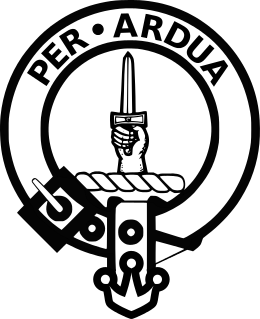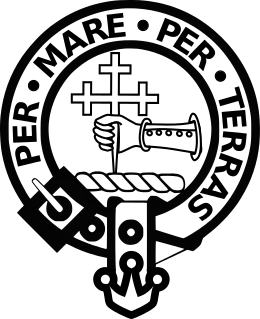Related Research Articles

Clan MacLeod is a Highland Scottish clan associated with the Isle of Skye. There are two main branches of the clan: the MacLeods of Harris and Dunvegan, whose chief is MacLeod of MacLeod, are known in Gaelic as Sìol Tormoid ; the Clan MacLeod of Lewis and Raasay, whose chief is MacLeod of The Lewes, are known in Gaelic as Sìol Torcaill. Both branches claim descent from Leòd, who lived in the 13th century.

Clan Donald, also known as Clan MacDonald, is a Highland Scottish clan and one of the largest Scottish clans. The Lord Lyon King of Arms, who is the Scottish official with responsibility for regulating heraldry in that country, issuing new grants of coats of arms, and serving as the judge of the Court of the Lord Lyon, recognizes under Scottish law the High Chief of Clan Donald. Historically the chiefs of the Clan Donald held the title of Lord of the Isles until 1493 and two of those chiefs also held the title of Earl of Ross until 1476.

Clan Mackenzie is a Scottish clan, traditionally associated with Kintail and lands in Ross-shire in the Scottish Highlands. Traditional genealogies trace the ancestors of the Mackenzie chiefs to the 12th century. However, the earliest Mackenzie chief recorded by contemporary evidence is Alexander Mackenzie of Kintail who died some time after 1471. Traditionally, during the Wars of Scottish Independence, the Mackenzies supported Robert the Bruce, but feuded with the Earls of Ross in the latter part of the 14th century. During the 15th and 16th-centuries the Mackenzies feuded with the neighboring clans of Munro and MacDonald. In the 17th century the Mackenzie chief was made Earl of Seaforth in the peerage of Scotland. During the Scottish Civil War of the 17th century the Mackenzies largely supported the Royalists. During the Jacobite rising of 1715 the chief and clan of Mackenzie supported the Jacobite cause. However, during the Jacobite rising of 1745 the clan was divided with the chief, Kenneth Mackenzie, Lord Fortrose, supporting the British-Hanoverian Government and his relative, George Mackenzie, 3rd Earl of Cromartie, supporting the Jacobites.

Clan MacNeacail, sometimes known as Clan MacNicol, is a Scottish clan long associated with the Isle of Skye. Tradition states that, early in its history, the clan held the Isle of Lewis, as well as extensive territory on the north-western mainland. The earliest member of the clan on record is one 14th century John "mak Nakyl", who is recorded amongst Edward I of England's powerful West Highland supporters during the Wars of Scottish Independence. John Barbour's 1375 epic, The Brus, suggests that by 1316, the clan had switched allegiance to Robert I, and made a decisive intervention in the new theatre of Anglo-Scottish conflict in Ireland. The marriage of an heiress to the MacLeods of Lewis brought a severe loss of lands and power in the following generation, forcing the clan chiefs to relocate to the surviving estates on Skye. However, the MacNeacails retained local significant influence: serving, according to tradition, as members of the Council of the Lords of the Isles and as custodians of the cathedral church of the Western Isles at Snizort. In the 17th century, members of the clan began to Anglicise their surname from the Scottish Gaelic MacNeacail to various forms, such as Nicolson. Today the English variants of the Gaelic surname are borne by members of the clan as well as members of unrelated Scottish families, including the Lowland Clan Nicolson.

Clan MacDonnell of Glengarry is a Scottish clan and is a branch of the larger Clan Donald. The clan takes its name from Glen Garry where the river Garry runs eastwards through Loch Garry to join the Great Glen about 16 miles (25 km) north of Fort William, Highland.

Castle Tioram is a ruined castle that sits on the tidal island Eilean Tioram in Loch Moidart, Lochaber, Highland, Scotland. It is located west of Acharacle, approximately 80 km (50 mi) from Fort William. Though hidden from the sea, the castle controls access to Loch Shiel. It is also known to the locals as "Dorlin Castle". The castle is a scheduled monument.

Clan MacKinnon or Clan Fingon is a Highland Scottish clan associated with the islands of Mull and Skye, in the Inner Hebrides.

Clan MacIntyre is a Highland Scottish clan. The name MacIntyre, means "son of the carpenter" Although no documented history of the clan exists, it is most commonly said to descend from Maurice Mac Neil a nephew of Somerled, the great 12th century leader of the Scottish Gaels. Through an ingenious strategy, Maurice secured the marriage of Somerled to the daughter of the King of Mann and the Isles, thus greatly increasing Somerled's territories. At an unknown date the clan journeyed from the Hebrides to the Scottish mainland where the chiefs established their home at Glen Noe, in Ardchattan Parish, on the east side of Loch Etive.

Clan MacDonald of Clanranald, also known as Clan Ranald or Clan Ronald, is a Highland Scottish clan and a branch of Clan Donald, one of the largest Scottish clans. The founder of the MacDonalds of Clanranald is Reginald, 4th great-grandson of Somerled. The MacDonalds of Clanranald descend from Reginald's elder son Allan and the MacDonells of Glengarry descend from his younger son Donald. The clan chief of the MacDonalds of Clanranald is traditionally designated as The Captain of Clanranald and today both the chief and clan are recognised by the Lord Lyon King of Arms, the heraldic judge in Scotland.

Clan Macdonald of Sleat, sometimes known as Clan Donald North and in Gaelic Clann Ùisdein[kʰl̪ˠan̪ˠ ˈuːʃtʲɛɲ], is a Scottish clan and a branch of Clan Donald — one of the largest Scottish clans. The founder of the Macdonalds of Sleat was Ùisdean, or Hugh, a 6th great-grandson of Somerled, a 12th-century Lord of the Isles. The clan is known in Gaelic as Clann Ùisdein, and its chief's Gaelic designation is Mac Ùisdein, in reference to the clan's founder. Both the clan and its clan chief are recognised by the Lord Lyon King of Arms, who is the heraldic authority in Scotland.
The Statutes of Iona, passed in Scotland in 1609, required that Highland Scottish clan chiefs send their heirs to Lowland Scotland to be educated in English-speaking Protestant schools. As a result, some clans, such as the MacDonalds of Sleat and the MacLeods of Harris, adopted the new religion. Other Clans, notably the MacLeans of Morvern & Mull, MacDonalds of Clanranald, Keppoch, Glengarry, and Glencoe, remained resolutely Roman Catholic.

Aonghus Óg Mac Domhnaill, or Angus Og MacDonald, was a fourteenth-century Scottish magnate and chief of Clann Domhnaill. He was a younger son of Aonghus Mór mac Domhnaill, Lord of Islay. After the latter's apparent death, the chiefship of the kindred was assumed by Aonghus Óg's elder brother, Alasdair Óg Mac Domhnaill.
Dubgall mac Somairle was an apparent King of the Isles. He was a son of Somairle mac Gilla Brigte and Ragnhildr Óláfsdóttir. Dubgall was a leading figure of Clann Somairle, and the eponymous ancestor of Clann Dubgaill. Dubgall's career is obscure, and little is certain of his life.
A tacksman was a landholder of intermediate legal and social status in Scottish Highland society.

A clan badge, sometimes called a plant badge, is a badge or emblem, usually a sprig of a specific plant, that is used to identify a member of a particular Scottish clan. They are usually worn in a bonnet behind the Scottish crest badge, or attached at the shoulder of a lady's tartan sash. According to popular lore clan badges were used by Scottish clans as a means of identification in battle. An authentic example of plants being used in this way were the sprigs of oats used by troops under the command of Montrose during the sack of Aberdeen. Similar items are known to have been used by military forces in Scotland, like paper, or the "White Cockade" of the Jacobites.

The MacMhuirich bardic family, known in Scottish Gaelic as Clann MacMhuirich and Clann Mhuirich, was a prominent family of bards and other professionals in 15th to 18th centuries. The family was centred in the Hebrides, and claimed descent from a 13th-century Irish bard who, according to legend, was exiled to Scotland. The family was at first chiefly employed by the Lords of the Isles as poets, lawyers, and physicians. With the fall of the Lordship of the Isles in the 15th century, the family was chiefly employed by the chiefs of the MacDonalds of Clanranald. Members of the family were also recorded as musicians in the early 16th century, and as clergymen possibly as early as the early 15th century.
Kermac Macmaghan was a thirteenth-century Scottish nobleman. In 1262, he is stated to have aided William I, Earl of Ross in a particularly vicious attack in the Hebrides. The assault itself is recorded by a thirteenth-century Scandinavian saga, and was likely conducted on behalf of Alexander III, King of Scotland, who wished to incorporate Isles into the Scottish realm. The following year, Hákon Hákonarson, King of Norway launched an expedition into the Isles to reassert Norwegian authority. The latter's campaign proved to be an utter failure, and after his departure and death the same year, the Scots forced the submission of the leading magnates of the Isles. In 1264, Kermac is recorded to have received compensation for services rendered. A fifteenth-century pedigree concerning Clan Matheson seems to indicate that Kermac is identical to a certain Coinneach mac Mathghamhna, ancestor of the clan. The latter may or may not be an ancestor of Clan Mackenzie.

The Books of Clanranald are two paper manuscripts that date to about the early 18th century. The books are written in Classical Gaelic, and are best known for their traditional account of the history of Clan Donald. The manuscripts are commonly referred to as the Red Book and the Black Book. The name "Red Book", however, may actually be a misnomer. Although Gaelic tradition on South Uist notes a "Red Book of MacMhuirich", it is uncertain whether this book is identical to the surviving manuscript. In fact, the manuscript may be partly derived from the red book of tradition. The name "Black Book" may have been coined in order to distinguish it from the so-called Red Book.
Raghnall Mac Ruaidhrí was an eminent Scottish magnate and chief of Clann Ruaidhrí. Raghnall's father, Ruaidhrí Mac Ruaidhrí, appears to have been slain in 1318, at a time when Raghnall may have been under age. Ruaidhrí himself appears to have faced resistance over the Clann Ruaidhrí lordship from his sister, Cairistíona, wife of Donnchadh, a member of the comital family of Mar. Following Ruaidhrí's demise, there is evidence indicating that Cairistíona and her powerful confederates also posed a threat to the young Raghnall. Nevertheless, Raghnall eventually succeeded to his father, and first appears on record in 1337.
Ane Accompt of the Genealogie of the Campbells is a seventeenth-century source documenting the history of Clan Campbell.
References
Primary sources
- Macphail, JRN, ed. (1914). Highland Papers. Publications of the Scottish History Society. Vol. 1. Edinburgh: Scottish History Society. OL 23303390M.
Secondary sources
- MacGregor, M (2002). "The Genealogical Histories of Gaelic Scotland". In Fox, A; Woolf, D (eds.). The Spoken Word: Oral Culture in Britain, 1500–1850. Politics, Culture and Society in Early Modern Britain. Manchester: Manchester University Press. pp. 196–239. ISBN 0 7190 5746 9.
- MacGregor, M (2008). "Writing the History of Gaelic Scotland: A Provisional Checklist of 'Gaelic' Genealogical Histories". In McGuire, NR; Meek, DE; Ó Baoill, C (eds.). Caindel Alban: Fèillsgrìobhainn do Dhòmhnall E. Meek. Scottish Gaelic Studies. Aberdeen: University of Aberdeen. pp. 357–379.